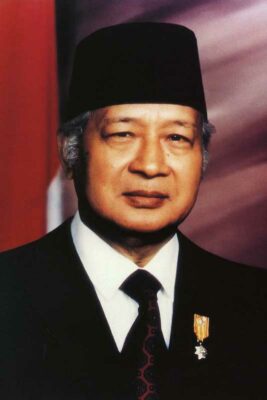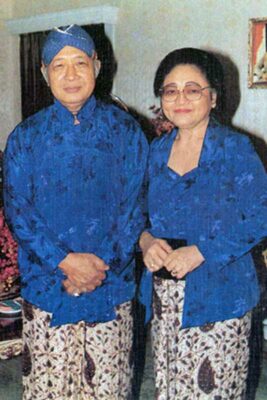Michael Susanto
Music as Language
To think of music as a kind of language is perhaps acceptable in the minds of many. As the popular saying goes: “Music is a universal language,” or the like.
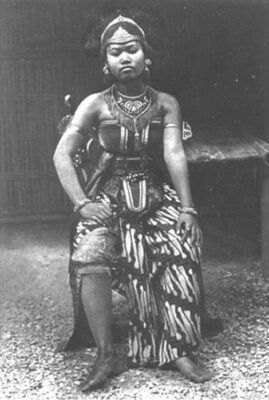
Revue de l’Exposition Universelle de 1889 tome 1 fig.112 bis — héliogravure d’après cliché de J. Levy et Cie — Bibliothèque Forney1[1]
What interests me in particular is the conceptions and prejudices behind this popular expression. The concept of universal language and the notion of music as language perhaps disclose some dissatisfaction on the one hand, and some aspiration on the other.
One interpretation is that language fails to convey a sense of universal meaning humans deeply share. It might be useful to cite Derrida’s idea of logocentrism in this regard, which I will elaborate on in the following.
Structuralism, as a philosophical tradition, holds the view that language can be understood in terms of signifier and signified. The former refers to the arbitrary nature of language. For example, words like dogs or cats do not have inherent connections to the entities as such. They sound familiar to the English speakers, but perhaps uncanny to those who are alien to this particular language. In this sense, these words are arbitrary and do not present meaning in themselves; hence they are called the signifier.
On the other hand, dog, anjing, or 狗 (gǒu), address the same thing as such, which is barking at times, four-legged, and waves its tail during excitement. This transcendental meaning is called the signified.
Having understood what signifier and signified mean, we can grasp Derrida’s neologism more easily. Logocentrism is the assumption that meaning presents itself all the time in words. That is, the naivety that words have inherent connections to meanings, the belief in the immediateness of truth in words (Logos could be translated as ‘word’).
Such philosophical premises Derrida termed as ‘metaphysics of presence’.
Now, my question is: Could it be that, behind the notion of music as language, there lurks some discontent on the failure of language in addressing universal human ideals? The resentment towards the oppressive usage of language in science and politics? On the other side, is it actually a sign of aspiration for free, unlimited language… for unity?
A Case Study of Gamelan music: from Paris to Debussy
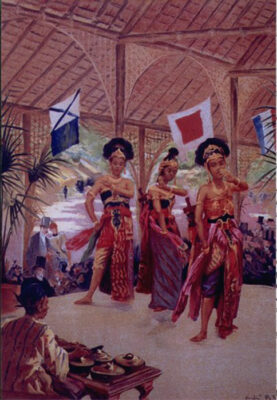
Revue de l’Exposition Universelle de 1889, tome 1 fig.104 bis — gravure d’André Brouillet — Bibliothèque Forney[1]
To answer these questions, a case study from my own origin, Indonesia (more specifically Java), might be useful.
First of all, I am not trying to claim myself as an expert in Javanese culture. However, I learned a thing or two about it in high school, and I believe that could be useful.
Javanese music has a characteristic of pentatonic scale (penta means five, tone means musical sound). This means, the music is mostly played within this range of five pitches.
Another characteristic of this music is that, of all the instruments, the mysteriously dull-sounding gamelan is most popular at scene — perhaps my personal bias, but I tend to associate the sound of a gamelan with something rounded as opposed to sharp-angled.
Western history is not so much alien to Javanese music. During the Exposition Universelle (1889), where the Eiffel Tower was exhibited to the global spectators for the first time, the young Debussy found himself enchanted by the musical performance at the Javanese Pavilion (Kampong Javanais at Trocadero).
What is more interesting in the show is that the music was embodied in the movements of young dancers. Debussy was inspired by the scale system and produced a composition known as Pagodes four years later. In 2019, the French Embassy and Institut Francais d’Indonesie hosted the 130th anniversary of Exposition Universelle at one of the finest concert halls in Jakarta.
Thanks to the effort made by my school’s headmaster, all students in our high school had the opportunity to witness the event free of charge. We were lucky enough to perceive the sound of the exact gamelan instrument Debussy was exposed to back in 1889. The gamelan is originally from Sumedang and now under the ownership of Museum Geusan Ulun.
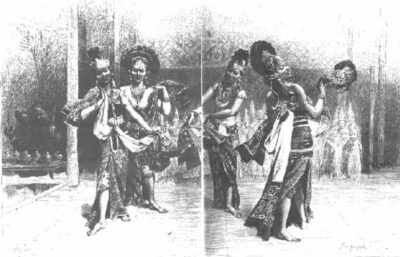
If you invite yourself to a gamelan party, you will notice that the music does not really have a beginning or an end. It is more like an eternal cycle, rather than a finite line.
Stories are not conveyed in the music — there are no ‘fast-slow-fast’ movements, nor apparent dynamics to make the piece dramatic. In other words, there is no meaning in the music itself — what Derrida called ‘metaphysics of presence’.
Music in the Javanese universe mimics the arbitrary nature of ordinary language. That is, in more fancy terms, music is the pure set of signifiers. Its place is in the background, and its significance is being-assumed-away.
Linear or Circular?
I am not trying to be logocentric here, but if I were to describe Gamelan music, it seems to be something more circular rather than linear. First of all, what is a line? A sceptic would argue that line does not exist, since every attempt of drawing it only results in a slim rectangular shape. Hence, a line, conceived this way, is nothing more than a concept. On the other hand, line is in essence a property constitutive to shape. It builds shapes such as rectangles and triangles. Perhaps a more useful attempt to define line was given by the mathematician Euclid. In his book Elements, Euclid postulated that a line is a “breadthless length” which lies between two points. If a line is that which lies in between two points, then we can say that it assumes the most tension. Even further, it is the creating force of tension itself. For without such a line, the two points are simply of random occurrence: they are not related. By establishing a line between them, some people believe, the most primordial binary opposition was created: the alpha and the omega. Under this reading, the two points become the beginning and the end. Had the line not existed, there would be no sense in talking of beginning and end. After all, they were simply unrelated dots. Consequently, if there is a beginning and an end, the line could be conceived as a ‘closed determination’. I shall call such determination, ‘purpose’. By purpose, I rather mean the ‘From – To’ kind of relation, the very basic sense of direction. Line, therefore, is not all there is. Alternative universe such as circle also exists. This is where the story changes.
Eternity versus Eternal Life
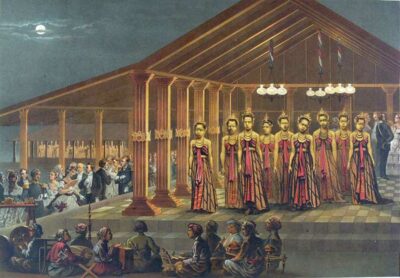
It seems intuitive to reify eternity as a circle. And this makes more sense than the linear concept of eternity. I shall call the former ‘eternity’ and the latter ‘eternal life’. Eternal life seems to be a fake eternity. It is nothing more than the human projection of how he perceives time. An extrapolation of his conscious experience. But he forgot that actually his life mimics a circle more than a line. For it was nothingness that precedes him, and by equal chance nothingness that succeeds him. Thus, eternal life is not a convincing argument for eternity. It appears to be the fake one. If so, what does eternity actually mean then? In this paradigm, there is no beginning or end. It simply appears to be an endless repetition of motion. Why motion? Because from my human perspective, I always assume time and produce a history out of it. I am not a pure timeless entity, and my perspectives are not neutral from prejudices and assumptions. Now, how does this relate to Gamelan music? What does it mean that Gamelan music is rather circular?
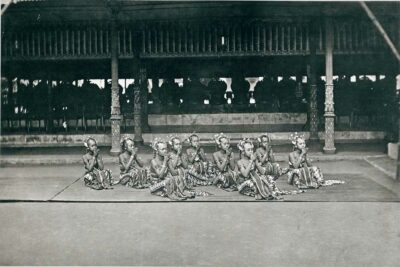
As I said earlier, I conceive of circle as eternity, and eternity as repetition. If you listen to Gamelan music, you would not find any particular direction. There is no movement reaching a specific endpoint. The music consists merely of repetition. You will encounter the same patterns again and again. It repeats on. This could mean two things: boredom and sameness. At one point in history, Javanese people were divided between two religious groups: the Hindus and the Buddhists. It culminated in their religious imaginations such as Lord Shiva (the trinity god of annihilation) fighting against the Buddha. After a fierce battle, with both sides at an equal position, they realized that though different, they were actually one. This idea gave birth to the famous formulation ‘Bhinneka Tunggal Ika,’ which simply means ‘Unity in Diversity’. The saying is to be found in an old Javanese poem Kakawin Sutasoma, written in the 14th century by Mpu Tantular. I am citing history here to make the point that the idea of oneness and the spirit of unity have long been part of Javanese people. In Gamelan music, there seems to be an echo of this idea of oneness. One perceives the constantly repeating pattern in the music. It does not build up to anything or lead to anywhere. It remains the same reoccurring pattern. At this point, there is no wonder if some people would ask, “What is the point of all this?”
Language as Music: A case study of Javanese parlance ‘Muter-muter’
Just as we do not ask “What is the point of language?” we probably pose the wrong question here. There are things we simply do not ask about, things we do not bring onto our judgement. We just assume the way they are, and accept it. When we learn a foreign language, we do not ask why the grammatical rules are so and so. And most likely, the native speakers do not know either. To repeat what I have said before, these structural means are normally arbitrary in themselves — just like ordinary language — and have a nature of being-assumed-away. They are the background, which sets the condition for the foreground. In fact, most of the time, Gamelan music does not stand on its own. It is performed together with its embodiment: dances or plays.
Having said all this however, I think there could be a legitimate case in which Gamelan music may have a significant influence. I argued that the music consists mostly of repetition and mimics something circular, rather than linear. In Javanese, there is a parlance (a type of speech) well known to everyone. We call this parlance, ‘muter-muter’. This translates to as ‘going around’. Basically, the opposite of straightforwardness. Javanese people are known to be indirect. They are perhaps a good example of non-logocentrism: they do not assume the truth in what you say. They know language is an arbitrary yet necessary means to communicate. Perhaps in their eyes, language is like a practice or ritual, in that the reason has long gone forgotten, yet the doing remains. Nevertheless, they carefully read the other signs like facial expressions and on-going situations. In short, they work out the entire context in their minds. For they do not seem to believe in the plainness and explicitness of language.
There is a body of research within the field of music cognition, which suggests that the rhythm of one’s language corresponds to the rhythm of his or her music. According to this research (2003), French music, for example, has higher successions in their rhythm than English music. In the same way, this might also be the case for Gamelan music, in that its repetitive nature appears to mimic the parlance I described above — muter-muter. To elaborate more on this, I will recite a case in politics.
A Case Study of Soeharto’s Politics: Symbolic Language and Authoritarian Music
Indonesia was for 32 years under the presidency of Soeharto. Allegedly, he stood among the masterminds of the coup against Soekarno, the founding father. He was a brave soldier, noted for his competency in Papua. Soeharto was fascinated by Javanese mystics since childhood. His interest was cultivated by a local guru named Darjatmo, who combined shaman practices and kebatinan (spiritual insights). According to some historians, Soeharto’s interest in mysticism led him to building a “powerful symbolic language” in his politics. Many who experienced his regime regarded his language as ‘confusing’ — they described it as ‘muter-muter’. On national television, he consistently gave the impression of being an obscurantist. He even appointed somebody to clarify what he said later on. This vague parlance did not only manifest on the individual level, but also institutionally. Departemen Penerangan (literally means Department of Illumination/Clarification) was established during the independence period to facilitate propaganda.
Their main purposes were (1) to declare Indonesian independence and (2) to let the world know about it. Under Soeharto, this propaganda function was brought to its maximum.
But I am not going to elaborate more on the bloody history of Soeharto’s regime. This little excerpt is enough to make my case.
The problem started when Soeharto appointed a spokesperson or even an institution to interpret what he had to say to the people. In other words, he made his language absolute. I argued earlier that language is in fact arbitrary; it does not assume any truth in itself. This implies that there is no absolute meaning in any texts — be it written or spoken — no objective truth, no legitimate reading whatsoever. It is an open field of interpretation. The only reason people come to the same understanding is that they confer in the same context at one particular moment. Many people understood that Soeharto’s smile could mean death for some people — after all he was called ‘the smiling general’ — because they lived in that contextual setting. However, to his oligarchs — the so-called cukong — that could mean something else; approval on infrastructural projects is one example. In short, language is a multidimensional space, which is full of interpretative potentials. Understanding, on the other hand, is the social aspect of language. By definition, it cannot happen with less than two people — even in self-dialogue there is the self who poses questions and the self which attempts to answer. For understanding always assume a giver and a receiver. And these two sides are independent of the other. It would be sad to receive what one intends to give. Thus, understanding is in essence a communal activity. It is a contextual and consensual economy of language. Understanding should not be dictated by a Dictator. It is where freedom lies and genuine actions are conducted.
The Implications: What then?
Since language is an open field, and textual activities — writing and reading or speaking and listening — imply free actions, any attempt to establish one absolute interpretation would be authoritarian. The parlance of muter-muter often causes confusion in the process of understanding. However, aside from some arbitrary political ends, this is actually a positive sign of a democratic society. Confusion prompts active listening, and even misunderstanding for that matter is the result of creative interpretation. In fact, there is no point in being correct for the sake of correctness itself. As far as it is concerned, the only value of correctness is its usefulness to bring people together, integrate society, and with that achieve certain goals. This manifests clearly in the realm of norms: mores, etiquettes, laws, and so on. With regard to Gamelan music, the implications we discussed in language (muter-muter) also apply here with equal relevance. There is no single right interpretation of what the music means. It is not sad, nor happy, nor angry, nor heroic. It transcends the idiosyncratic nature of human experience. As it was said before, the endless repetition which mimics something circular brings one instant soul to the One. Here, the idea of sameness — remember the historical excerpt of religious feud in Java — serves to unite different listeners into one all-encompassing, all-embracing reality. In the face of reality, differences does not matter. The appearance may differ to various degree, but the essence resides in one boundless existence.
To sum up what I have discussed so far, language does not assume truth in itself, and hence it is arbitrary. I demonstrated this in a case study of Gamelan music, which might not have an ultimate meaning in itself, but rather facilitates transcendental moves. The circular pattern in Gamelan music seems to correspond to the Javanese parlance of muter-muter, which culminated in the symbolic language of Soeharto’s politics. Instead of letting the people engage in a creative discourse, he chose a legitimate interpreter to convey the absolute meaning of his confusing speech. In this sense, there is no room for confusion or misunderstanding. To avoid death, one has to be correct. Thus, authoritarianism is the political implication of denying the open-endedness of language, making one interpretation absolute, condemning creativity and mistakes. In short, of defining freedom. To return to our foremost question, behind the popular saying, “Music is a universal language,” perhaps lurks the aspiration for a free non-oppressive language, where creativity could flourish and diversity be united.
Suggestions to Listen
- Karawitan — Klenengan Gamelan Gending: https://youtu.be/p5pgPolmuKo Klenengan is a type of Gamelan show performed solely without dances or plays. Gending, on the other hand, indicates the cyclical punctuation style of the music.
- Claude Debussy — Pagodes (Pagodas) in B major from Estampes, L. 100 (1903)
- Colin McPhee — Balinese Ceremonial Music (1934-1938)
- Leopold Godowsky — Java Suite (1925)
Leopold Godowsky was a virtuoso pianist of Russian-Jewish descent. Many considered him as one of the greatest pianists of all time. Rachmaninov admired his musical techniques and performances. Rubinstein claimed it would need five hundred years for him to have such a mechanism as Godowsky’s. Even further, Busoni remarked him as one of “the only composers to have added anything of significance to keyboard writing since Franz Liszt.” Godowsky was inspired by Gamelan music upon his visit to Java. He wrote the Java Suite in 1924-25. The Suite consists of twelve movements, and each of them describes a particular scene he encountered in Java. Through this suite, Godowsky brings his listeners on a short trip to Java. It starts with the first movement Gamelan, the temple Borobudur, the Mount Bromo, and many more. - Peter Lee — Majapahit: Indonesia’s Spice Kingdom from the travel documentary series The Mark of Empire (2020)
|
Leopold Godowsky — Java Suite (1925) |
Claude Debussy — Pagodes (Pagodas) in B major from Estampes, L. 100 (1903) |
|
Colin McPhee — Balinese Ceremonial Music (1934-1938) |
Peter Lee — Majapahit: Indonesia’s Spice Kingdom (2020) |
- Euclid, Dana Densmore (Ed.) (2002) Euclid’s Elements
- Patel, Aniruddh D. & Joseph R. Daniele (2003) An empirical comparison of rhythm in language and music https://doi.org/10.1016/s0010-0277(02)00187-7
- Peter Carey, Peter (1974) The Cultural Ecology of Early Nineteenth Century Java
- Ricklefs, M.C. (2001) A History of Modern Indonesia
- Vlekke, Bernard H.M. (1943) Nusantara
- West, David (2010) Continental Philosophy: An Introduction
Notes
[1] Source: Les Danseuses Javanaises
[2] Source: The court of the Sultan of Yogyakarta (c. 1876). Performance of Bedhaya Sacred Dance accompanied by Javanese Gamelan Ensemble — drawing by F.C. Wilsen, Tropenmuseum Amsterdam
[3] Source: The bedhaya dancers doing a sembah (tribute) to the Sultan of Yogyakarta (1884) — photo Kassian Cephas, Leiden University Library
[4] Source: Indonesian President Suharto (1993) – State Secretariat of the Republic of Indonesia
[5] Source: Suharto and his wife in Javanese costume (2013) – Presidential Library






